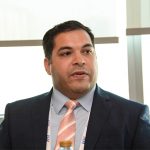GIB Asset Management UK gathered together key industry players in February in Dubai to discuss how trade finance can be made an attractive asset class for private investors, what is holding banks back from originating and distributing more of their assets to investors, and the increasingly important role ESG is playing in investments.
Roundtable participants:
Basel Al-Hussein, Dubai branch manager, International Islamic Trade Finance Corporation (ITFC)
Maninder Bhandari, director, Derby Group (chair)
Doug Bitcon, head of credit strategies, Rasmala Investment Bank Limited
Ian Henderson, senior portfolio manager, GIB Asset Management UK
Rahul Jayakar, head of global transaction services, trade and sales, Noor Bank
Vatandeep Nagpal, trade sales relationship manager, Abu Dhabi Commercial Bank (ADCB)
Adil Nawaz, trade product control and product management specialist, Abu Dhabi Commercial Bank (ADCB)
Amitji Odedra, associate director, Qbera Capital
Anirudha Panse, managing director and head of trade product management, First Abu Dhabi Bank (FAB)
Erik Viljoen, fund advisor, Barak Fund Management
Bhandari: What are your views on trade finance as an asset class? It has been reported that only 80% of the trade that requires financing gets financed. Will private or institutional investors come in and help close this gap?
Henderson: With banks’ compliance costs and other regulations approaching in different areas, financial institutions need to be efficient with their capital. They are always looking for new distribution. We need to see more institutional investors coming into the space that understand the risks and the return profile of trade, so that banks can manage their balance sheets better.
Alternative financiers can’t plug that gap on their own, so it’s really about more collaboration with institutional investors that may not have thought of trade as an asset class. It’s a stable product with relatively low default rates, but defaults and loss ratios depend on the risk category being targeted in order to meet investors’ return demands.
Bitcon: Is that gap actual physical trades that need financing, or is it traders that are looking for financing? There are a number of reasons why the banks are pulling back; one is regulatory. There are also operational risks, and trade finance is not as simple as buying a bond or buying an equity. It’s highly structured.
Some of the funding that is being filled by alternative financiers is not scalable in the same way as an equity fund or a fixed income fund. So, when the money comes in, you then probably take six weeks to two months to actually deploy that liquidity.
Bhandari: Why has this asset class not seen more interest, growth and investment?
Panse: It’s a bit of a mindset change for the banks. A lot of global banks view risk distribution as a business and others do this activity only if there is a dire need. The reason why I say it is a mindset change is because banks are very happy to hold on to the assets they originate and seldom say ‘no’ to a business because they don’t have enough credit limits or they don’t have enough credit appetite, for example. The thought process is never for them to originate it and distribute it later, so the overall portfolio can be managed.
This mindset change needs to happen within the banks, and for a number of reasons. This is a great way of managing risks for the banks themselves. They can originate and keep on distributing. If they keep on distributing, they also know that means it’s a liquid asset and that gives them a lot of comfort in being able to do more business, because they know that other banks are also viewing the risk the same way that they are. It is short-term and self-liquidating.
Jayakar: The overall growth in the industry is predominantly based on the fact that a lot of actors who are associated with it have not really grown it. In the biggest transactions that we originated, we saw that all relevant players needed to be sitting together along with the banker in order to conclude the transaction. A lot of structuring is required because the objectives of the buyer are very different from those of the supplier. They need to see how the transaction will impact their balance sheet and how it’s going to benefit them in terms of putting their ratios together.
There are a number of factors which come into play, and that is where trade has moved on. If we compare trade to our day-to-day transactions, it is far more distinctly customised.
The banks that have managed to adopt customised trade flows in line with their clients, understanding the risks better, have actually managed to grow.
Now, as to why these transactions are getting rejected, if you look at a recent survey of large multinational banks, there is almost a 55% rejection rate on account of two reasons. The first is a lack of financial data and the second is because of compliance. I’ll keep compliance away because that’s a common factor – it impacts practically everybody.
But a lack of financial data is something we can work on.
Odedra: When large investors look at it, they look at that 80% which is financed by the banks and the trade finance funds. They are not really interested in the other 20%. As an institutional investor, you want those investment-grade-esque types of ideally corporate credit risk or very simple FI risk. And the way that they see the arbitrage is, ‘okay, if I’m buying BP or Google or any other trade finance transaction, what is the comparison?’ And that is a short-dated commercial paper (CP) or bond, and generally, there is a pickup when you maturity adjust the bond or the CP relative to the trade finance.
The liquidity premium is important. If a corporate’s paper is trading at 50 basis points (bps) on the bond side, the trade finance might be at 65 or 70 because of a few differences – it may be one of the operational entities, it’s got an illiquid element and it’s priced on capital. That’s where that extra 15 or 20bps comes from. From an investor perspective, that’s what they like. The bigger challenge is how to articulate trade finance, and that’s an issue that bankers on the trade finance side haven’t yet mastered. If we get into more granular details, the trade is backed by a bill of lading or letter of credit, then that just confuses many investors because all they are used to doing is: Bloomberg, click, buy.
Bhandari: Do you find that origination itself is difficult and distribution is easy, or vice-versa?
Nagpal: First of all, the transparency and the financial data is not enough for us to originate from or focus on particular markets. The 20% is the market where nobody is still going. But what I have seen in the last few years, is that we at ADCB have started tapping those markets on the origination side. It is slightly more difficult to convince stakeholders, but, yes, it’s a risky market and that is why there are less takers for it.
Panse: Origination is easier, because distribution has the mindset of giving away part of the revenues. When the assets are getting distributed, the overall returns improve as risk-weighted assets are reducing and returns are increasing through the fee income (in case of a true sale). Many banks may consider distributing the assets only if this is made a pre-condition by their credit team to allow origination of the transaction.
Jayakar: Clearly, the fundamentals of distribution have not changed. The journey starts with identifying a particular market where the bank feels comfortable in terms of taking an exposure. The second part of that is, do we have the ability to originate? If not, then we look for a partner who is able to, and there are multiple parameters which come in over that. What is the credit rating of the originator? Does the originator have an on-the-ground presence in case something happens? The third part is, what is the kind of theme and what is the understanding of this particular asset that has been originated? And then, banks, depending on who the distributors are, would try and build in parameters: so let’s say if I am a double-A rated bank then I would not buy an asset from a lower rated bank, even if the underlying asset were worse rated.
Odedra: To me, a bank selling a risk to another bank does not make it an asset class. It’s just a simple risk transfer. It’s much more about institutional investors, asset managers and so on. The way I look at it is, what are they looking for? I don’t think any investor actually says, ‘I want trade finance’. They say, ‘I want something uncorrelated, something short-term in duration and something that gives me a yield pickup’. What fits in that box? Trade finance. So, it’s not a case of them looking for trade finance. It’s an asset that has those characteristics.
Bhandari: How would this asset class be made simpler to attract or grow an investor’s appetite?
Odedra: Two big things have happened. One is something that we used to do at HSBC, which is to wrap assets, either single or portfolios, into an ISIN-based format. So, all an investor does is go onto Bloomberg and buy it like a bond, and it makes it simple. On the other side are the fintech platforms, the Tradeteqs and CCRMs of this world, because again, they simplify the asset to, say, counterpart, price, tenor, country, into an asset bucket that someone looks at and then buys.
Those platforms enable access for alternative investors. If I am a pension fund in the Netherlands or wherever, and go to a bank and try to buy direct, unless they have a note format or a securitisation format, and there are not so many trade finance securitisations, you can’t get exposure unless you book loans. Large investors want big tickets, say US$100mn or more, and start where the yields are perhaps lower, in that investment-grade-esque type range. To them, 6% or 7% where trade finance funds like Qbera operate, is sometimes outside of their mandate to start with, and that’s where having a platform actually enables them access in a simple way whilst they build their knowledge of funds.
Henderson: What we are trying to do as an asset manager is simplify the investment process for the institutional investors. We understand trade and we access trade assets through risk participation agreements with banks, funds and corporate lenders to deploy the funds invested with GIB Asset Management following a robust investment process.
Bhandari: What is holding banks back from originating trade finance assets?
Henderson: If you are originating and distributing, there is a reputation aspect that goes with that. If you distribute bad assets, your reputation is at risk, and so some banks may be reluctant to distribute at the same level. On the origination side, knowing what the regional appetite is in a market like this is important, given there are key banks and a limited set of select borrowers. You can’t actually sell more risk to the banks as they all have maximum exposure limits. That’s why you need the external investors to compliment and add distribution capacity.
Adil: Compliance is another issue. We know that from the banks’ perspective in different geographies, we have more or less similar compliance structures. Maybe for a certain bank, dealing with a certain entity or geography would be easier on the compliance side, and it would sail through. But for us, it might not be the case. So, if I am buying an asset from a bank, the transaction details would be very comfortable for that bank, but they would not be familiar to me. Because of how things have shaped up geopolitically, there are certain geographies in which there are a lot of grey areas in terms of US or European regulations.
Bhandari: From ITFC’s perspective, do you see better appetite from corporates or other investors coming into trade finance as an asset class?
Al-Hussein: We are a generator of trade finance opportunities, and we receive a lot of interest from our current stakeholders as well as potential stakeholders to participate with us in our arranged syndications and trade finance deals, especially where the focus is on the developmental aspect. Trade finance has an inherent developmental aspect that can help economies grow and deliver towards achieving the SDGs. So, there is an interest in the market, but you need to build awareness around it.
Currently, the institutional investors that join us, for example banks, other MDBs, wealth funds or specified facilities, aim for a certain developmental outcome of their participation, as well as a return on their investments. They do so mainly because this is to help emerging markets, and OIC member countries, make sure that the most critical economic sectors are served.
Bhandari: Is there perhaps a specific industry or geography that investors would be particularly interested in, which can be matched more easily with receivers of this funding?
Adil: Bangladesh is one example. Eight to 10 years back there were a lot of social issues in the garment industry, a key economic driver in the country. Today, Bangladesh is where most of the green factories have been built and the working culture of employees has improved drastically. Eight or 10 years ago, banks were not very keen on buying or originating assets from Bangladesh. Now there is huge demand.
Viljoen: From a return versus effort perspective and with this big network of trade finance opportunities, we do see openings to do longer-term transactions. A client who is already doing a fertiliser import is renting warehouse space. We know how much he’s paying for that warehouse space and that justifies putting up his own storage, and he can pay that off over a five-year period. It’s not to go out there and do long-term deals, but it’s on the back of these trade finance opportunities with clients that you’ve got relationships – there are often opportunities to go slightly longer in your tenor.
Jayakar: Very specifically in this part of the world, what we have seen is originators like to hold on to their clients more closely and hence they do not look at the bigger picture in terms of trying to enhance their appetite on the same client requirement, because they are very happy with maintaining limits or increasing the limits internally rather than actually looking at other avenues.
Bhandari: The number of investors who look at ESG as a principle of a transaction is high, yet the amount of transactions that get invested in are low. Why is that happening, and is there a regional aspect to it?
Henderson: ESG is not new in the asset management industry. When it comes to trade finance and some of the private credit markets, it hasn’t been a major consideration. Trade itself has inherently got a lot of impact and it’s easier to implement ESG or point out the ESG factors in your transaction. We evaluate those issues already. They’ve just never been articulated and quantified in a transaction.
From a trade finance perspective, as the originators, as we put those deals in, it’s up to us to drive that process from the bottom up. A lot of institutions have sustainability policies at the top because their stakeholders and shareholders have insisted that they are in place, but it has not trickled down into the business units as yet in terms of being a consideration in your day-to-day business.
From a regional perspective, people say, ‘oh, the Middle East doesn’t worry about it’, but I think that’s not true. You’ve got to look at the 2030 vision from Saudi Arabia, and the similar one coming from the UAE, and there are some fundamental pillars that are being driven. If you look at Europe, there has been some regulation coming in for the banks on tackling climate change and the impact on their portfolios due to climate change, and these initiatives will start spreading, but I think we are in the early stages. It’s a work in progress. The trade funds are trying to get a common approach, and if you speak to any fund, it’s a work in progress with obtaining the data. There is no set model of what it should look like or what reporting should look like. I think we still have a long way to go.
Panse: All market constituents need to work together in driving the importance of ESG in trade financing. While there is interest from clients, many are also looking for cheaper sources of funding under the umbrella of ESG. There is nothing wrong with that. However, banks today don’t benefit from a cheaper cost of funding for ESG, which could then allow them to pass on benefits to their clients.
Bhandari: Is the ESG aspect critical to the process for inviting investors in?
Odedra: Not necessarily, and it depends on the type of investor you are targeting and the jurisdictions. A lot of the Nordic investors are probably the most developed from an ESG perspective. For others, they consider it, but again, unless as an originator you are able to articulate clearly what ESG means in your context, it doesn’t make sense. As Ian says, ESG is something that has always been considered, but the weighting is now changing, as is the ability to quantify and report on it.
Bitcon: Everyone’s talking about ESG. Its momentum is building massively and we are getting questions from investors saying ‘what is your ESG position?’ Rather than having specific concerns with respect to investors, we are looking closely at the transactions that we are financing, some of which are in coal, for example. In terms of those transactions, our credit insurers are going to come under ESG pressure, and we need to start thinking about our position: if we don’t get credit insurance on those transactions, do we still continue to fund?
In this region, they aren’t as concerned about ESG; it’s not a high priority right now coming from petro-dollar economies.
Viljoen: Take coal in South Africa as an example. Now, European banks are saying ‘no more, we don’t want to do this, coal is not where we want to be’. But at the moment, that’s the cheapest source of electricity in some countries. Do you want to push up electricity prices on your consumer, impacting a whole host of people? I think ESG rules, or how you interpret those, are not the same for emerging markets compared to a developed market.
However, trade finance as an asset class is extremely well positioned with ESG. If we look at our portfolio, there are commodities coming out of Africa being bought from small-scale farmers: those stories are there throughout the portfolio. We’re quite excited about ESG and what it can do for us in the future.
Bhandari: How do you marry the developmental aspect to an ESG perspective? Is regulation important?
Al-Hussein: There are specialised trade houses that consider the developmental aspect over the commercial aspect. For an MDB such as ITFC, we care about the developmental aspect, because this is all about providing necessary support through the developmental tools in order to help our member countries to grow and enhance the livelihood of people in these countries. If you look at the specialised trade houses that are corporates focused on trade activities, they have a lot of developmental programmes in their markets and although, yes, they are benefiting and they are making money out of it, they do have a tangible developmental outcome of their activities as well. When you look on the other side in commercial banking, the main focus is ‘how much can I generate out of it?’ Unfortunately, the current investment opportunities lie with that side of the business. It is our responsibility to build comfort with potential investors in the market through systems such as blockchain to offer suitable and transparent investment tools for them.
If the focus is on certain sectors, then it can be easily regulated. But when you are talking about different aspects of different economic sectors, each country has its own regulations regarding trading certain commodities. For example, cotton trading in Uzbekistan is completely different to trading cotton out of Burkina Faso. There are a lot of differences in the regulations and the nature of the trade contracts are totally different between these two countries. Regulation is something to work towards and will take some time.
Nagpal: The ESG footprint in the banks in this region has been there, but it has been small for quite a long time. But now with the multilaterals coming in and helping the banks to originate more, it’s becoming more like a team game where we join up with the MDBs and then focus on originating. If the regulatory aspect is added, it will be very important.
Odedra: Putting multilaterals and DFIs aside, I’ve seen lots of firms saying that they are allocating X million or X billion to ESG or impact and both of those are very separate investments. What have they gone and done? They’ve bought green bonds, but have access to little else, perhaps some equities that meet ESG criteria.
Their challenge comes in finding assets that fit the standards they have perhaps set themselves.
For trade finance, the challenge then is also on the originator side, which is, what are you going to be able to communicate? Because at the moment, we are not even able to clearly communicate the trade finance structure to them. How are you going to be able to communicate a uniform ESG structure and metrics for quantification? We all, or a majority of us, need to put together a similar template of assessment and quantification.

















